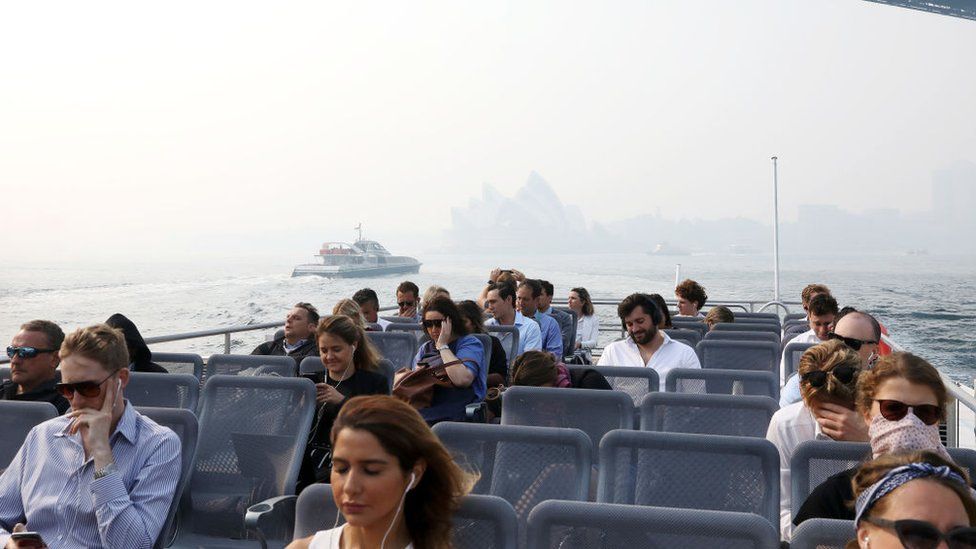Australia bushfires: Pollution concerns for tennis tournament
- Published

When tennis player Dalila Jakupovic was unable to complete her qualifying match for the Australian Open, which begins on Monday, she blamed the "unhealthy" air quality caused by fire smoke. Bushfires have been burning across Australia for weeks, causing air pollution which can be harmful to health.
Ms Jakupovic criticised the organisers for letting the match go ahead in those conditions, as she and several other tennis players experienced effects, including coughing and difficulty breathing, nausea and muscle cramps.
How harmful is bushfire smoke?
Breathing in smoke can cause irritation in the eyes, nose, throat and lungs. In more serious cases it can lead to hospital, especially for people with pre-existing respiratory conditions.
As trees, leaves and other ground vegetation burn, they release small particles of solid carbon, water vapour and gases including carbon monoxide.
Ultrafine particles of less than 2.5 micrometers - referred to as PM2.5 - pose the biggest risk to health because they can bury deep into the lungs and even enter the blood stream. This risks irritation, infection and an increased chance of heart attacks and lung disease.
Professor Francesca Dominici, a statistician who works on public health, conducted a recent study into the effects of exposure to particulate matter. She found it was linked to hospital admissions for a wider range of conditions than previously thought.
As well as the known effects on the lungs and heart, her team identified "new diseases including septicaemia which is a serious bloodstream infection... urinary tract infections and renal failure," she told ABC News.
Bushfire pollution does not typically do as much lasting damage as traffic or industry pollution, according to Associate Prof Brian Oliver, an expert in respiratory disease from the University of Technology, Sydney, because conditions often lift with a change in weather.
This means any breathing discomfort is mostly short-lived.
But because many fires have been burning for weeks, and authorities warn that there is no immediate end in sight, experts say this should now be treated as medium-term exposure.
Who is this affecting?
Bushfires have been burning across the country, often sending smoke over populated areas.
Residents of Sydney - Australia's largest city - have endured smoke for weeks. The city's air quality has exceeded "hazardous" levels on several occasions.
That has led to a 10% rise in hospital admissions, say officials. Paramedics have treated hundreds of people for breathing problems.
Adelaide - a city of 1.3 million - was also affected last month, with its residents told to stay indoors.
Because PM2.5 particles found in bushfire smoke are so small - a ninth of the size of a grain of sand - they can travel huge distances on the wind, potentially affecting many more people. The smoke is expected to make "at least one full circuit around the globe," according to the US space agency Nasa.
Most vulnerable are children, the elderly and smokers, while those with asthma, heart and lung problems can see exacerbated symptoms - such as chest tightness and difficulty breathing.
And, as competitors in the Australia Open tennis tournament have experienced, athletes can be more susceptible to smoke damage because they are breathing in larger volumes of air as they exercise.
The more intense the exercise, the more extra air will be taken in.
Standard face masks are ineffective when it comes to blocking out fine particles, according to health authorities. They warned people to avoid exercising outdoors this week - a suggestion that many have ignored.
How bad has Australia's air quality been?
Australia's clear air standard is a PM2.5 level of eight micrograms per cubic metre. By comparison, smoking a single cigarette produces 20 micrograms per cubic metre.
Recent readings in Sydney have been as high as 734 micrograms - the equivalent of about 37 cigarettes.
The heavy smoke haze over Sydney last month
What about 'thunderstorm asthma'?
Smoke is an obvious health hazard that can travel vast distances from the fire front. But the weather stoking the flames has created other issues too, such as dust storms.
In Victoria, officials issued an "extreme" warning in November for a phenomenon known as "thunderstorm asthma".
This is where strong winds create more pollen in the air, which can lead to an outbreak of asthma attacks. In 2016, nine people died in Melbourne from just such an outbreak.
Bushfires can actually create their own weather systems, which may exacerbate this effect, according to Rachel Badlan, a researcher at the University of New South Wales.
If it covers a large enough area, the upward movement of hot air from a fire can interact with the atmosphere and form a pyrocumulonimbus - a cloud of smoke, ash and water vapour which comes alongside massive thunderstorms.
Pollutants from these storms are flung into the stratosphere - more than 10km into the earth's atmosphere - according to Nasa.
Reporting by the BBC's Frances Mao. Additional reporting by Rachel Schraer.
- Published28 November 2019
- Published21 November 2019
- Published13 November 2019
- Published14 November 2019